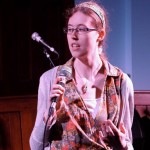
Festival Five Ws Part 2: Tracy Chevalier in Conversation
Ex-Ilkley Young Writer and Writing Squad member Amy Luxton explores the Whos, Whats, Wheres, Whens and Whys of the Festival!
 What?
What?
At the Edge of the Orchard, Chevalier’s new novel.
When?
Mid-1800s.
Where?
Pioneering America.
Who?
The ‘who’ was the big question during this event. Chevalier’s novels always use strong characters as a channel for the past, and her new book is no exception. Her reading of Sadie, the twisted mother figure in At the Edge of The Orchard, brought pure personality instantly to the room, transporting the audience to a less-than-ideal America through the petty irritations and sadistic games of Sadie’s isolated world.
What strikes me about Chevalier’s characters is their interconnection, their dependency, which often weaves the story around them. The simultaneous friendship and rivalry of Elizabeth and Mary in Remarkable Creatures; the fixation of Vermeer and Griet in Girl with a Pearl Earring. In At The Edge of the Orchard, Sadie creates a vicious, claustrophobic environment that forces her son Robert from his home, a domino effect of intertwined lives. And it doesn’t stop there. Chevalier is writing in opposition to the idealised myth of frontier America, and her story could not exist without the work of previous writers, such as Laura Ingalls Wilder. It was particularly interesting to hear that Chevalier had taken up quilting after writing her previous novel, The Last Runaway. Her books are very much like a quilt, stitched together from voices of the past.
The theme of patchwork tales continued as Chevalier moved on to discuss Reader, I Married Him, the new collection of short stories she has edited. Any anthology is necessarily a collection of ‘who’s’, and twenty-one different authors in a single book can’t help but bring tens of new experiences to life. The book is inspired by Jane Eyre, continuing the Brontë fever of Charlotte’s bicentenary. This crossing over of texts brings yet more voices to the table – the Brontës, their characters, and everyone influenced by them since. Chevalier is writing the ‘who’ of our past, the hundreds of other lives before us that make up our own perceptions. When we open a strong-voiced historical novel like At the Edge of the Orchard, or a collaborative effort like Reader, I Married Him, it forces us out of our present era, our present understanding of the world. As Chevalier said, we are more than a moment. We are a product of everything and everyone before us, and writing lets us feel a part of the voices of our past.
Why? Because a voice can make or break a story, and Chevalier certainly knows how to make one.
 Amy Luxton is a twenty-one year old graduate of English and Creative Writing at Lancaster University. Born in West Yorkshire, she was a long standing member of Ilkley Young Writers and is currently a member of the northern-based Writing Squad and enjoys working with themes of place and history in prose, poetry and non-fiction.
Amy Luxton is a twenty-one year old graduate of English and Creative Writing at Lancaster University. Born in West Yorkshire, she was a long standing member of Ilkley Young Writers and is currently a member of the northern-based Writing Squad and enjoys working with themes of place and history in prose, poetry and non-fiction.
 Support the Festival!
Support the Festival!